access and
support


Together, we got this
Let's talk coverage and support for your patients and about the resources available to help them along their treatment journey.
For patients who are enrolled in Takeda Patient Support, our support specialists are available to help you and your patients understand what financial assistance options may be available.
See eligibility requirements below.
HelloHYQVIA
Free Trial Program
Help patients who are eligible find out if HyQvia is right for them with a free trial of HyQvia.
See eligibility requirements below.
Coverage
Lookup Tool
Use this lookup tool to determine specific plan coverage information for HyQvia in your area. Search for local coverage by entering a ZIP code.
Help your patients access the treatment they need
Your patients may have questions regarding cost and coverage.
In this section, we have several educational resources to help you help your patients along the insurance journey.
Access Guide
The HYQVIA Access Guide is a tool for navigating the process of getting a patient's prescription approved by a health plan and managing the various coverage scenarios you may encounter.
Access Guide
Benefits investigation
Does my patient have coverage?
How much are their out-of-pocket costs?
Dual Benefit Brochure to help you understand the differences in coverage across Medical and Pharmacy Benefit.
Or you can access your patient’s coverage information for HyQvia in your area by using our Coverage Lookup Tool.
Dual Benefit Brochure
There are some health plans that cover HyQvia under the medical benefit, the pharmacy benefit, or both. Learn how this dual benefit design can impact how HyQvia is acquired and reimbursed.
Appeals process
If a PA gets denied, you can appeal the decision. The Appeals Checklist can help keep you on track. Some common reasons for denial are:
- Missing or inaccurate information
- Step-edit requirement
- Incorrect diagnosis code(s) submitted
- Billed to the wrong benefit (ie, medical vs pharmacy). To learn more, a basic overview and comparison of the
2 benefit designs is detailed here - Site of care for infusion is not preferred/not covered
- Not covered on the formulary
Denials and Appeals Resource
Understand the appeals and denials process for both pharmacy and medical benefits.
Appeals Checklist
To assist with the PA and/or appeals process, use this checklist, which outlines documents to consider including.
Sample Letter of Appeal
Each appeal needs to clearly answer the reason for denial and the healthcare professional's clinical rationale. The sample letter can help get you started.
Reimbursement
HyQvia provides resources and information to help you process billing and diagnostic codes, as well as claim forms.
HyQvia Billing and Coding Guide
HyQvia is covered by many insurers for the treatment of patients. This guide contains common administrative and diagnostic codes related to HyQvia. The guide is provided for informational purposes and may not include all necessary codes.
CMS-1500 Claim Form
The CMS-1500 claim form is the standard claim form used to bill many government and private insurers. This sample is intended to assist you with completing the form for billing HyQvia and associated services.
Medicare Guide
The HYQVIA Medicare Resource is a guide that covers Medicare basics, site of care coverage considerations, and tips to help you obtain access and reimbursement for your patients who have been prescribed HYQVIA.
Support when your patients need it
Takeda Patient Support will provide your patients with resources from dedicated support specialists who will address your patients’ questions and concerns and help them get the information they need, and nurse professionals who will provide education about their condition and their prescribed Takeda treatment. If English is not your patient’s preferred language, we can assist them in a language of their choosing.
Patients enrolled in Takeda Patient Support will have access to:
Financial assistance support
Insurance support
Treatment and condition education
Takeda Patient Support Co-Pay Assistance Program*
If a patient is prescribed HyQvia and needs co-pay assistance, you can direct the patient to enroll in the Takeda Patient Support Co-Pay Assistance Program. The program can cover up to 100% of your patient’s out-of-pocket co-pay costs, if they’re eligible.† A support specialist can review your patient's coverage and determine eligibility.
Eligibility
- Be prescribed HyQvia
- Have commercial insurance. This includes health insurance marketplace plans
- Be enrolled in Takeda Patient Support
See below for terms and conditions.
If your patient has government insurance
Takeda Patient Support can help answer questions about their prescribed Takeda treatment coverage.
If your patient can’t afford treatment
Takeda Patient Support may be able to connect them to programs that may help.
Enroll patients today.
There are 3 ways to enroll.
Visit our convenient
online enrollment portal
Download and fax the
completed Start Form to
1-866-861-1752
Call Takeda Patient Support
at 1-866-861-1750,
Monday through Friday,
8 AM to 8 PM ET
*IMPORTANT NOTICE: Takeda’s Co-pay Assistance Program ("the Program") provides financial support for commercially insured patients who qualify for the Program. Participation in the Program and provision of financial support is subject to all Program terms and conditions, including but not limited to eligibility requirements, the Program maximum benefit per claim and the annual calendar year Program maximum (“Annual Program Maximum”). The Annual Program Maximum for your prescribed Takeda product can be found by visiting: www.takedapatientsupport.com/copay
By enrolling in the Program, you agree that the Program is intended solely for the benefit of you—not health plans and/or their partners. Further, you agree to comply with all applicable requirements of your health plan. The Program cannot be used if the patient is a beneficiary of, or any part of the prescription is covered by: 1) any federal, state, or government-funded healthcare program (Medicare, Medicare Advantage, Medicaid, TRICARE, etc.), including a state pharmaceutical assistance program (the Federal Employees Health Benefit (FEHB) Program is not a government-funded healthcare program for the purpose of this offer), 2) the Medicare Prescription Drug Program (Part D), or if the patient is currently in the coverage gap, or 3) insurance that is paying the entire cost of the prescription. No claim for reimbursement of the out-of-pocket expense amount covered by the Program shall be submitted to any third-party payer, whether public or private
Some health plans have established programs referred to as ‘co-pay maximizer’ programs. A co-pay maximizer program is one in which the amount of a patient’s out-of-pocket costs is adjusted to reflect the availability of support offered by a manufacturer’s co-pay assistance program. If you are enrolled in a co-pay maximizer program, your Annual Program Maximum may vary over time to ensure the program funds are used for your benefit (for the benefit of the patient). Takeda also reserves the right to reduce or eliminate the co-pay assistance available to patients enrolled in an insurance plan that utilizes a co-pay maximizer program.
If you learn your health plan has implemented a co-pay maximizer program, you agree to notify the Program immediately by calling 1-866-861-1750. It may be possible that you are unaware whether you are subject to a co-pay maximizer program when you enroll or re-enroll in the Program. Takeda will monitor program utilization data and reserves the right to discontinue assistance under the Program at any time if Takeda determines that you are subject to a co-pay maximizer, or similar program.
The Program only applies in the United States, including Puerto Rico and other U.S. territories, and does not apply where prohibited by law, taxed, or restricted. This does not constitute health insurance. Void where use is prohibited by your insurance provider. If your insurance situation changes you must notify the Program immediately by calling 1-866-861-1750. Coverage of certain administration charges will not apply for patients residing in states where it is prohibited by law.
This Program offer is not transferable and is limited to one offer per person and may not be combined with any other coupon, discount, prescription savings card, rebate, free trial, patient assistance, co-pay maximizer, alternative funding program, co-pay accumulator, or other offer, including those from third parties and companies that help insurers or health plan manage costs. Not valid if reproduced.
By utilizing the Program, you hereby accept and agree to abide by these terms and conditions. Any individual or entity who enrolls or assists in the enrollment of a patient in the Program represents that the patient meets the eligibility criteria and other requirements described herein. You must meet the Program eligibility requirements every time you use the Program. Takeda reserves the right to rescind, revoke, or amend the Program at any time without notice, and other terms and conditions may apply.
†If your patient's medication is dispensed by a specialty pharmacy.

Patient resources
HelloHYQVIA Free Trial Program
Help your eligible patients* determine
if HyQvia is right for them
With the HelloHYQVIA program, patients may be able to try HyQvia for free to help you and your patient determine if HyQvia is right for them.
Start the enrollment process for your patients today.
HelloHYQVIA Free Trial Program Request Form
Complete the form and fax to 1-866-861-1617
Download the HelloHYQVIA Free Trial Brochure to learn more about the program
*Eligible patients must have an ICD-10 code verifying diagnosis, be a new patient not currently using HyQvia, and not have previously enrolled in the HelloHYQVIA program. Additional terms apply.
Patient education can play an important role in chronic disease management
Patient education is a vital component in caring for patients with chronic disease because it informs and involves patients in understanding both the disease state and the care instructions necessary for their condition. It also helps patients understand any lifestyle changes that they will need to make to help manage their condition. You can support your patients with the following resources.
Select Important Information for Healthcare Providers:
Indications for Use: HyHub/HyHub Duo are indicated for patients 17 years of age and older to allow HyQvia [Immune Globulin Infusion (Human), 10% with Recombinant Human Hyaluronidase] to be transferred from vials without using a needle, as prescribed, in a home environment or clinical setting.
Contraindications:
- Do not use HyHub/HyHub Duo with a pooling bag.
- Do not connect HyHub/HyHub Duo to a syringe driver infusion pump.
Click here for additional Important Information for HCPs.
Patients should not use HyHub/HyHub Duo at home until receiving instructions and training from a healthcare provider. For safe and proper use of HyHub/HyHub Duo, please refer to the complete Instructions for Use included with the devices.
Find comprehensive resources that provide support for your patients.
Explore comprehensive resources for your patients to help support them with their HyQvia treatment.


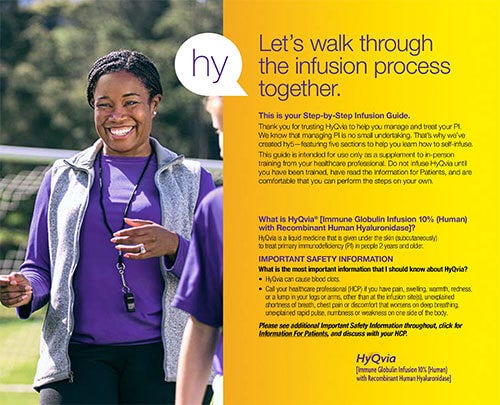
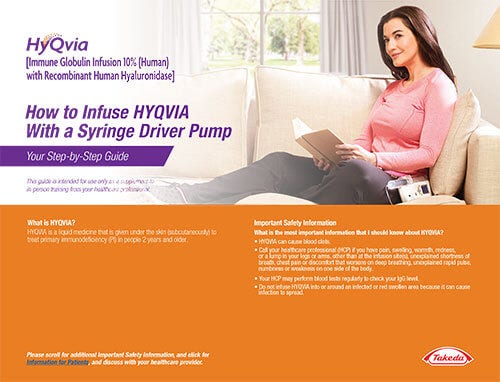
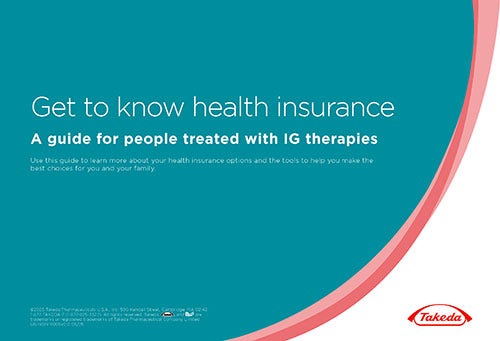
Support from the start with resources throughout their journey
Find a strong support community and education resources for your patients with primary immunodeficiency, regardless of treatment.
MyIgSource is committed to helping your patients manage a life with primary immunodeficiency (PI) at diagnosis and throughout their PI journey. From advocacy to learning about diagnosis, management, and living with PI, your patients and their caregivers, regardless of treatment, have access to:

- Learn more about PI and managing their condition
- Sign up to receive educational materials that can help them and their loved ones better understand PI
- Connect by phone or online with patient advocates that have PI or have loved ones living with the condition
- Register for events focusing on disease education related to PI
Have your patients connect at MyIgSource.com or call 1-855-250-5111.
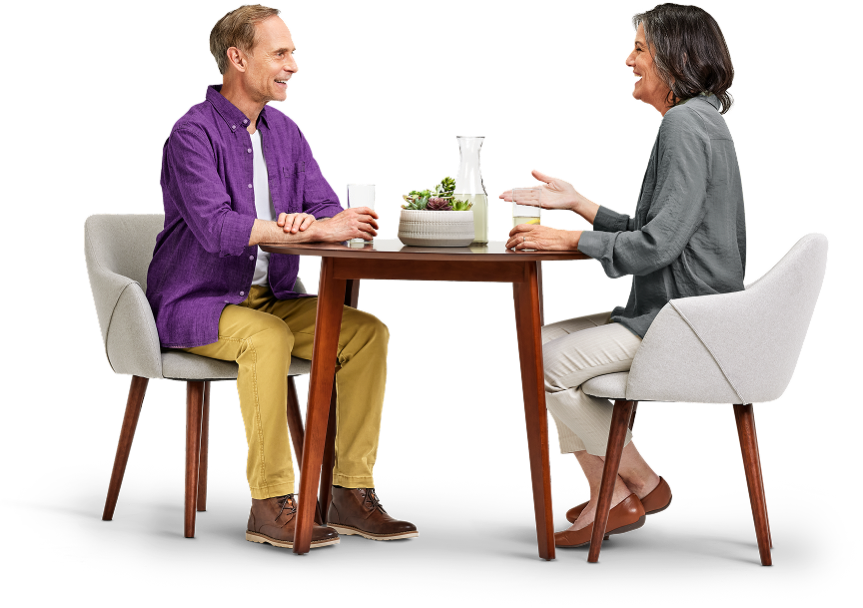
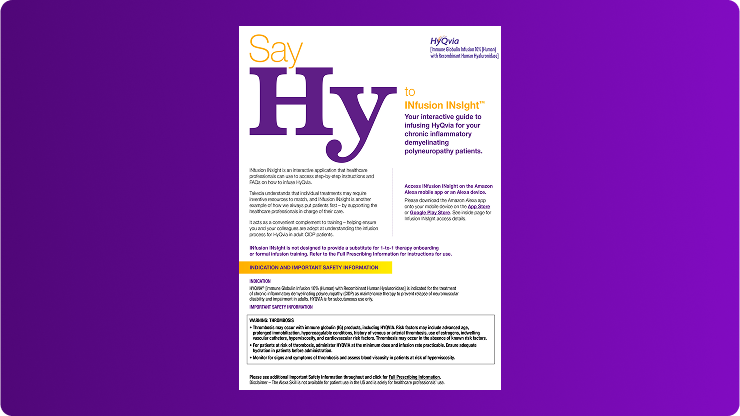



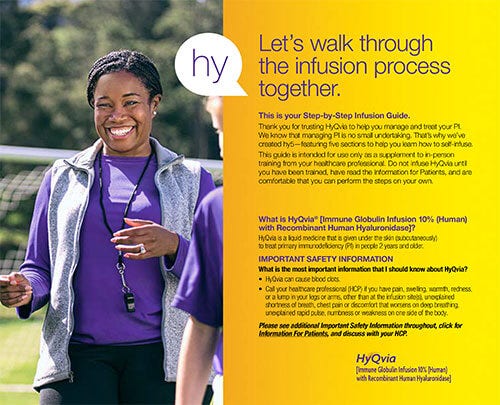

 , and
, and  are trademarks or registered trademarks of Takeda Pharmaceutical Company Limited. HYQVIA is a registered trademark of Baxalta Incorporated. HYHUB and MYIGSOURCE are trademarks of Baxalta Incorporated.
are trademarks or registered trademarks of Takeda Pharmaceutical Company Limited. HYQVIA is a registered trademark of Baxalta Incorporated. HYHUB and MYIGSOURCE are trademarks of Baxalta Incorporated.